 Dorota Biczel
Dorota Biczel
Wood, bronze, clay, fiber, oil paint, film: an expansive survey of work by thirty-four contemporary artists and collectives from the Amazon basin.
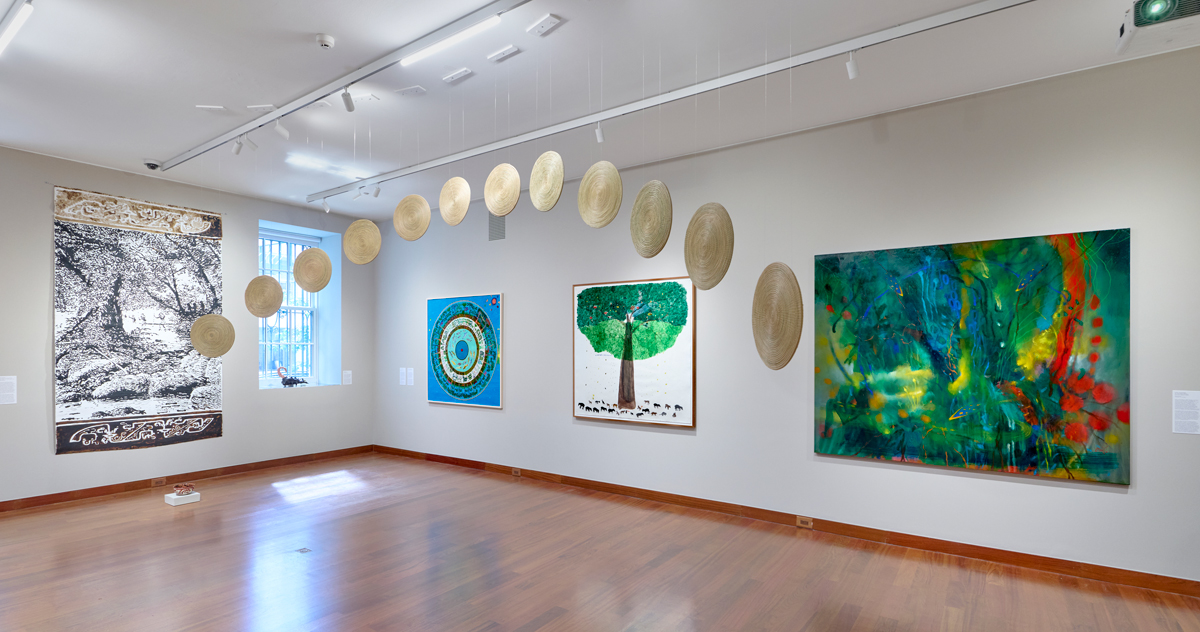
Amazonia Açu, installation view. Courtesy Art at Americas Society. Photo: Arturo Sanchez. Pictured, suspended from ceiling: Comunidad Weenhayek, Tata peyuka—soplador de fuego (Fire blower), 2025. Far right: Carlos Jacanamijoy, De naturaleza interior I (Of inner nature I), 2018.
Amazonia Açu, curated by Grace Aneiza Ali, Christian Bendayán, Elvira Espejo Ayca, Diana Iturralde, Miguel Keerveld, NouN and T2i, Mateus Nunes, Luis Romero, and María Wills, curatorial advisor Keyna Eleison, exhibition design by Solomonoff Architecture Studios, Americas Society, 680 Park Avenue, New York City,
through April 18, 2026
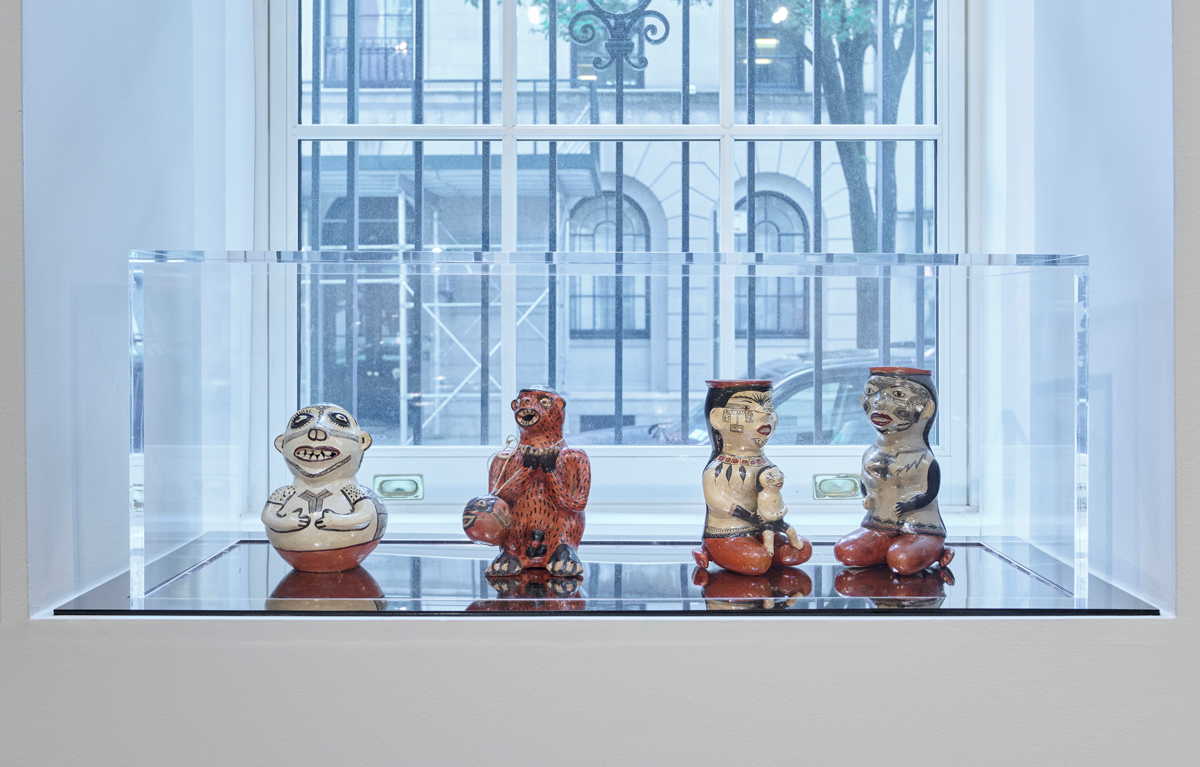
Amazonia Açu, installation view. Courtesy Art at Americas Society. Photo: Arturo Sanchez. Pictured, far left and second from left: Estela Dagua, Effigy (Supai), 1992–2004. Second from right and far right: Nancy Santi, Allpamama, 2025.
There is stunning intricate basketry; there are poignant ceramics, including painted baked-clay receptacles, small but richly characterized effigies of supai (forest spirits) and other mythical characters, and massive Flying Vessels that propel Indigenous designs onto Sputnik-like containers (in these traditional earthenware jars, both representational and abstract sculptural elements call forth ancient and contemporary legends, such as those of unidentified aerial phenomena). There are sensuous wood carvings, evocative bronze sculptures, and inventive, sometimes humorous, fusions of man-made and found natural materials. There is a mixed-media collage on raffia canvas, reappropriating archival and ethnographic imagery. There are two videos: a forest-sited recording of poetry in Guaraní and a lavish, high-production-value music film whose soundtrack permeates the exhibition space with a hypnotic slow beat invoking Manman Dilo, the incarnation of the mythical merwoman Mami Wata (Mother Water) in Guiana’s Creole culture. There are diverse weavings and textiles. Paintings and drawings showcase a similarly wide spectrum, both in terms of materials and pictorial approaches. (Four black-and-white, documentary-style photographs from Guyanese Darrell A. Carpenay’s expedition to Mount Roraima on the border of Guyana, Brazil, and Venezuela seem to stand apart, as they bring in the common, historically charged tool of an external observer, even if a sympathetic one.)
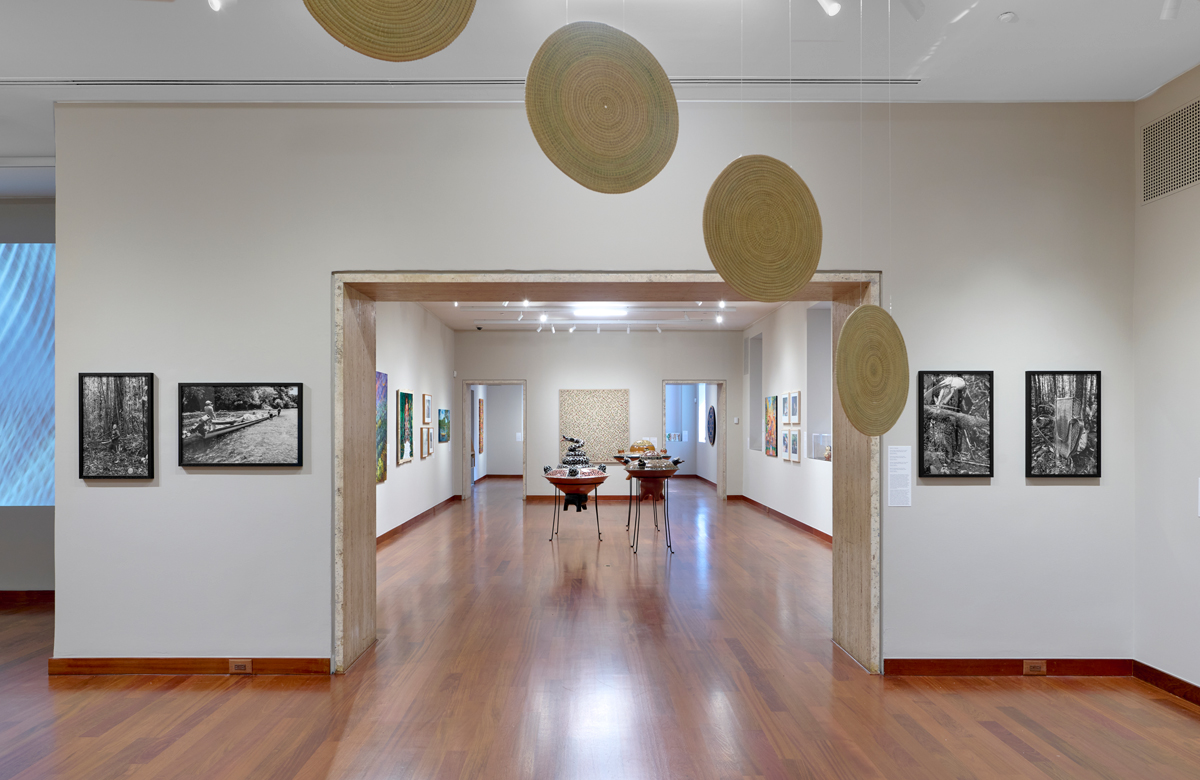
Amazonia Açu, installation view. Courtesy Art at Americas Society. Photo: Arturo Sanchez. Pictured, left and right foreground walls: Darrell A. Carpenay, from the series The Lost World, Mount Roraima, 2019.
This vast assortment of practices foregrounds the idea that Amazonia is not simply a geographic region that can easily be delineated on a map. It lives in many localities—as much in the expansive environs of the river and its many tributaries in the “provinces” of these nation-states and territories as it does in migrant communities far beyond, such as those established in large metropolises, like Cantagallo, the self-constructed Shipibo community in Lima. (The absence of Cantagallo’s dynamic artists here is an omission; and it’s worth noting that the entire Peruvian “representation” is comprised of works from just one private collection, Hochschild Correa.) Amazonia and attendant Amazonian imaginary also spill into the “Western” former colonial powers, such as France or the Netherlands, where people with roots in the physical region have chosen to settle and work.
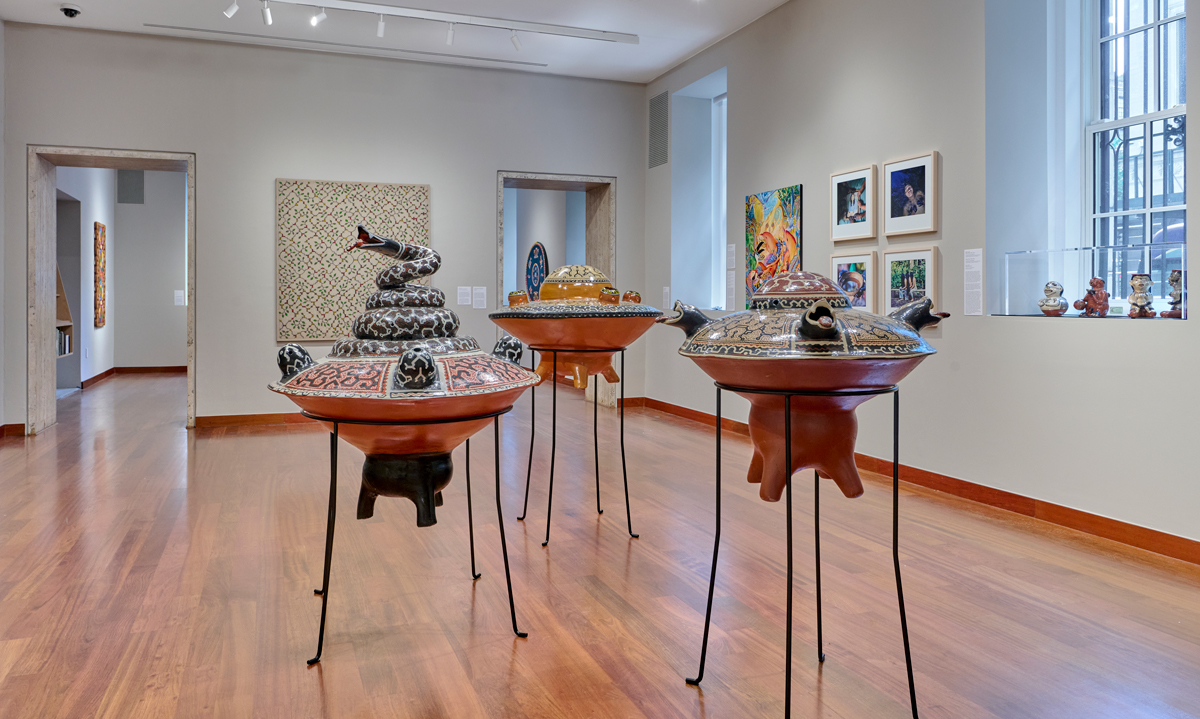
Amazonia Açu, installation view. Courtesy Art at Americas Society. Photo: Arturo Sanchez. Pictured, foreground: Agustina Valera and Oliver Agustín, Chomos voladores (Flying vessels), 2018–19. Center left, on wall: Sara Flores, Untitled (Pei Kené 1), 2019.
Reflecting this human overflow, some of the distinct Amazonian art-making practices in this show pertain to artists who have learned their craft in their local communities, from their ancestors, and who continue and expand their paths. Elegantly suspended across the final gallery, a constellation of twelve palm-plant fiber woven discs by the Bolivian collective Comunidad Weenhayek, titled Tata peyuka—soplador de fuego (Fire blower, 2025), evokes the everyday use of such goods to fan a fire’s flames. The geometric, mazelike kené designs of the Shipibo-Konibo animates not only the grand “flying” ceramic vessels but also fabric—Sara Flores painstakingly generates them freehand with natural dyes into a pulsating, ornate, abstract composition (Untitled/Pei Kené 1, 2019). The aforementioned effigies by Estela Dagua and Nancy Santi spring from a matrilineally passed-down practice known as awana (“weaving clay”).
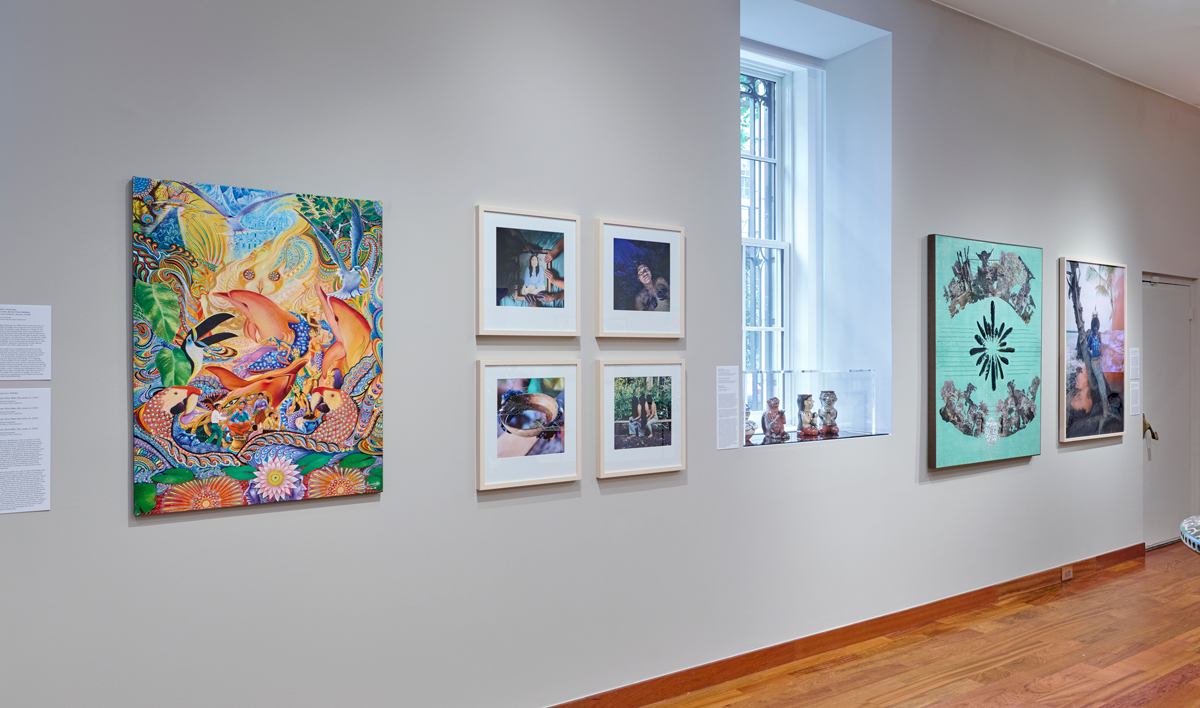
Amazonia Açu, installation view. Courtesy Art at Americas Society. Photo: Arturo Sanchez. Pictured, far left: Pablo Amaringo, El baile de los Puca-bufeos (Puca-bufeos’ dance), 2009.
Other artists in Amazonia Açu have melded their ancestral beliefs, knowledge, and ways of doing with “Western”-style art (what I mean here is the long tradition of pictorial representational conventions, with their attendant techniques and materials, as consolidated in Western European institutions, as well as their subsequent modifications and rejections), be it in a self-taught manner or as professionals trained in art schools and academies. The Peruvian healer-turned-painter from Pucallpa, Pablo Amaringo (1938–2009), rendered his quasi-pointillistic, psychedelic, fluorescent El baile de los Puca-bufeos (Puca-bufeos’ dance, 2009) in oil, showing a phantasmic city of elaborate towers hovering in the background of a scene of enormous intertwined dolphins and birds attended by miniscule humans and merfolk. De naturaleza interior I (Of inner nature I, 2018) by Colombian Carlos Jacanamijoy, of the Inga people of a larger Quechua community, is a painterly gestural abstraction that elicits the depths of a river teeming with abundant life. In Cuatro caminos (Four paths, 2024), Angélica Alomoto, Ecuadoran of Kichwa descent, paints with rubber sap and incorporates the Omagua people’s ancestral drawings symbolizing the spirit of the forest to transmute an image of the jungle taken from a history book. The same motifs decorate the small ceramic bowl, periodically filled with water, that completes the work. According to the artist, the evaporating liquid suffuses the exhibition space with something “as intangible as the spirits of the desecrated forest.” Thus, the path traced by Alomoto is the conceptual work of an artist/descendant/anthropologist/researcher. The glamorous and sexy renderings of Manman Dilo by NouN and T2i (France/French Guiana) in photography and video represent yet another, radically different approach to fusing old myths and contemporary aesthetics.
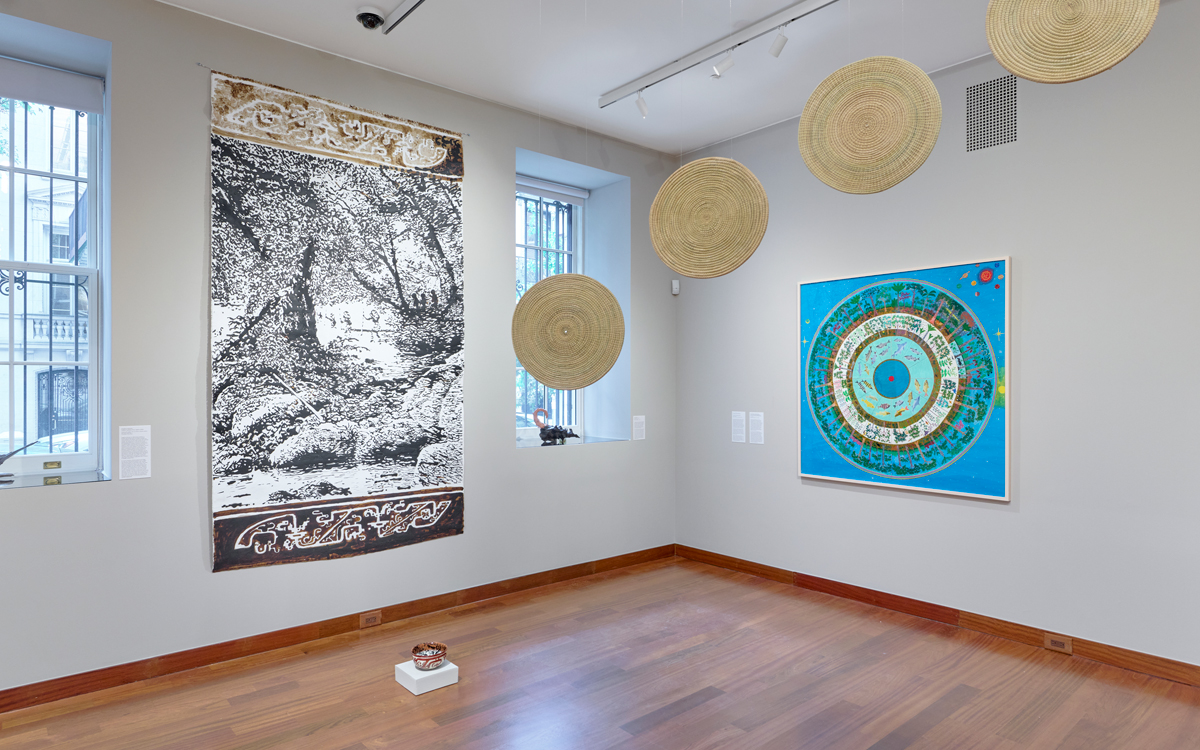
Amazonia Açu, installation view. Courtesy Art at Americas Society. Photo: Arturo Sanchez. Pictured, left wall and on plinth: Angélica Alomoto, Cuatro caminos (Four paths), 2024.
Still, some thorny questions arise, especially given the interest in and appetite for “Indigenous” arts in many cultural centers, as demonstrated by Adriano Pedrosa’s 2024 Venice Biennale, Foreigners Everywhere. While I am profoundly sympathetic to the urgent task of illuminating the complexity of Amazonia, and appreciate the curatorial effort to refuse to essentialize the region and to resist fulfilling demands for cultural “authenticity” from colonial metropolises, be they Venice, São Paulo, Paris, New York, or Lima, I also think the kaleidoscopic prism of Amazonia Açu obfuscates as much as it illuminates. For one, it eschews the challenge of how to effectively institutionalize those ways of making that have long been deemed “craft” or “popular art.” (As the history of exhibitions proves, putting “craft” and “high art” side by side is not enough to upturn the dominant ideas of what constitutes “art” in the long term.)
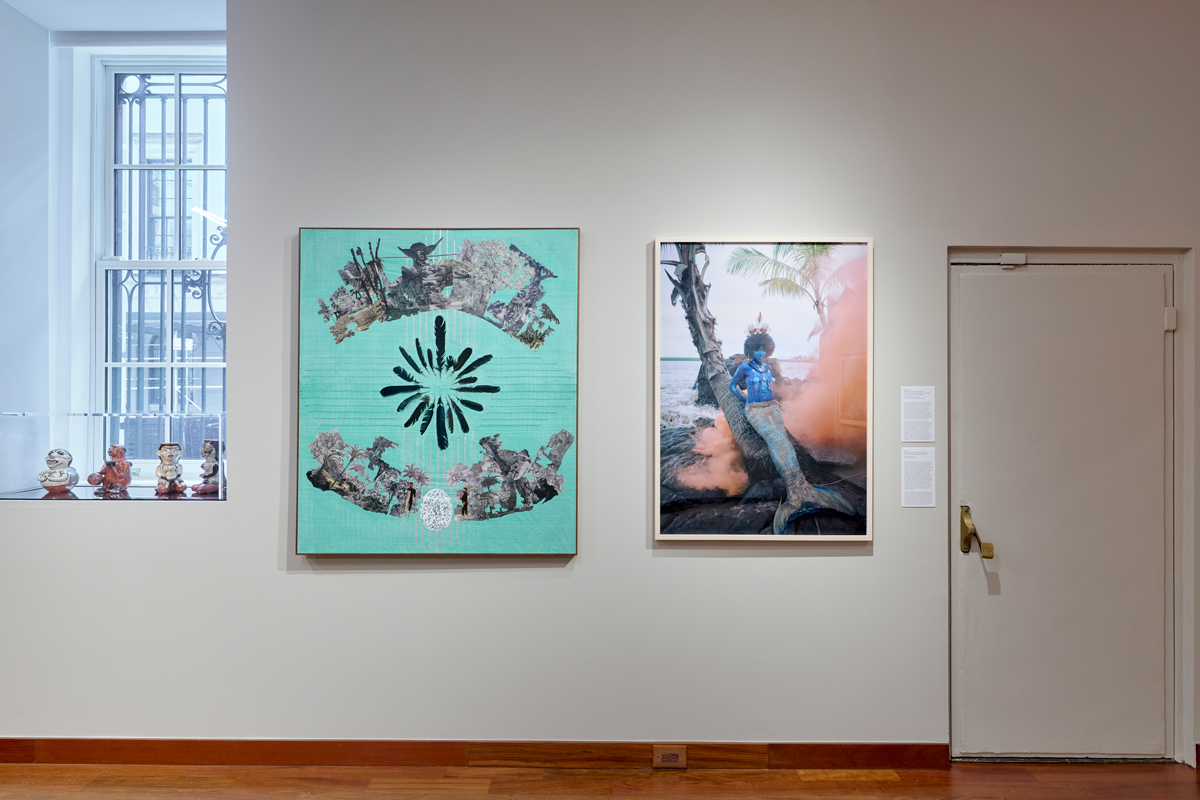
Amazonia Açu, installation view. Courtesy Art at Americas Society. Photo: Arturo Sanchez. Pictured, right: NouN, Mère des Eaux (Mother of Waters), from the series Manman Dilo, 2022.
But even more crucially, this celebratory, expansive, and optimistic take on Amazonian practices glosses over the vital problems in the region. The immense area and its localized producers face exceptional duress—not just in the past, but in the present—from climate change, to ongoing rampant extractivism and the incursion of new settlers onto their territories, to increasingly violent narcotrafficking. These urgent and pressing issues are absent from the show, unless framed as history, as in the painting-statement by Santiago Yahuarcani that renders “the era of rubber.” Likewise missing is the fact that Amazonia also includes peoples living in voluntary isolation who continuously face the onslaught of external encroachment, physically and legally. I fear this elision leans toward reproducing the old colonial trope of America, broadly speaking, and South America, in particular, as a new, resilient Eden, delivered for twenty-first-century viewers.
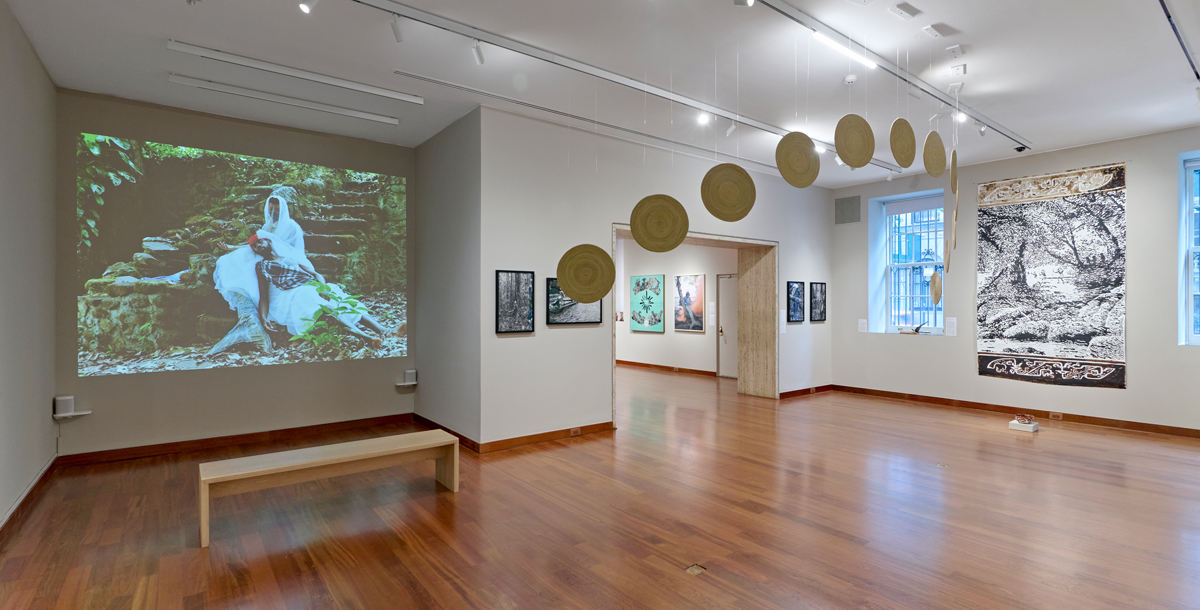
Amazonia Açu, installation view. Courtesy Art at Americas Society. Photo: Arturo Sanchez. Pictured, far left: T2i, Manman Dilo, 2022.
While Amazonia Açu offers a lot—and, in that sense, is a must-see—it also rescinds equally much. The question now is who will pick up the baton the exhibition extends, and how they will meet the challenge of being equivalently attuned to the multitude of Amazonias and being real to the struggles happening on the proverbial ground.
Dorota Biczel teaches art history and theory at Barnard College and occasionally curates exhibitions. She is currently working on a book, Precarious Subjects: Non-object-based Art, Migrations, and Political Transitions in Peru, 1968–1990.